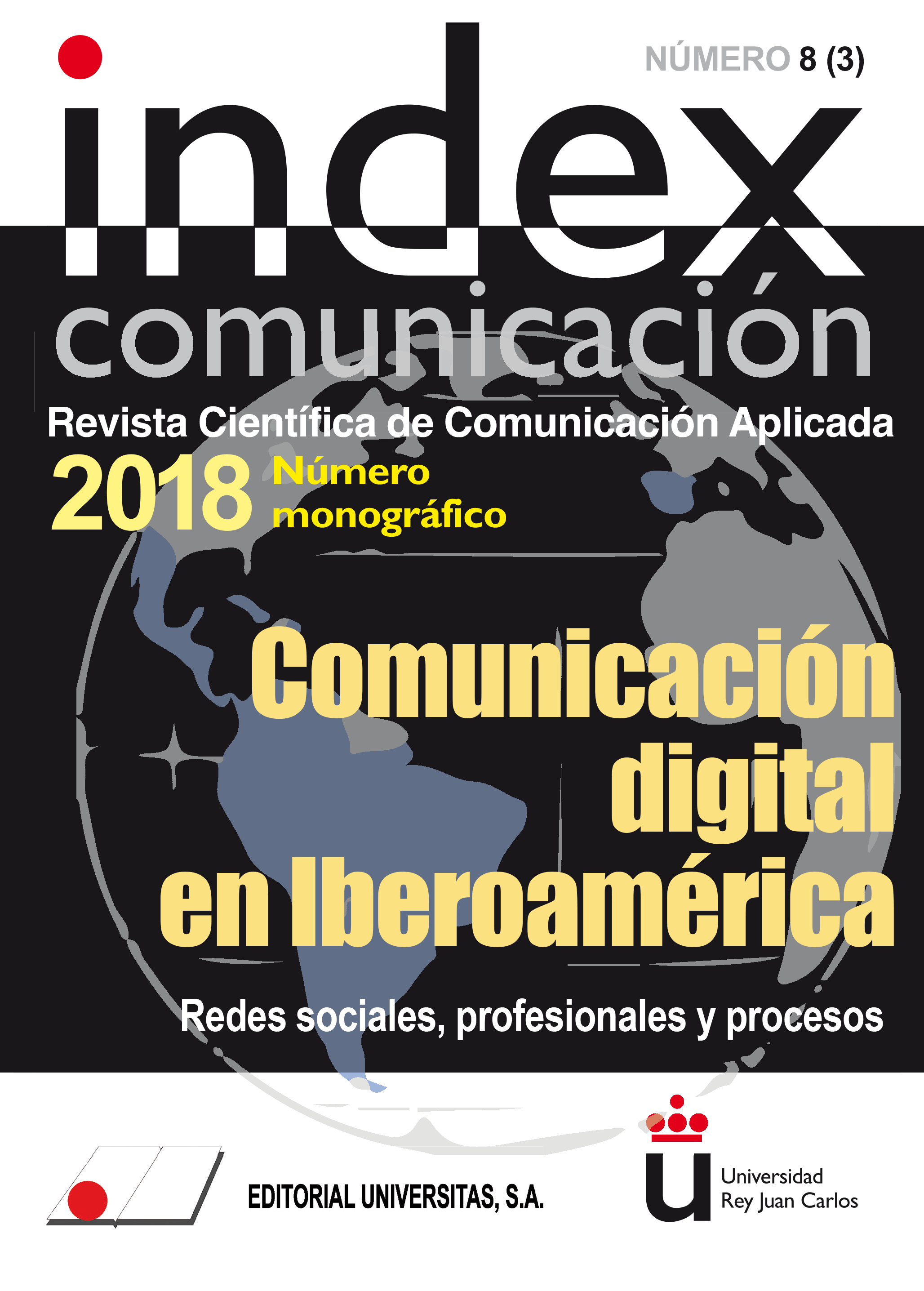Social media as news sources in Spanish digital media (‘El País’, ‘El Mundo’, ‘La Vanguardia’ and ‘ABC’)
Keywords:
social media, news sources, digital media, digital audiences, online journalism,Abstract
The research describes and analyzes the use of social media as news sources by the four digital newspapers most read in Spain. A no probabilistic sample of news extracted from the online editions of El País, El Mundo, La Vanguardia and ABC was analyzed quantitatively. The sample was formed by the news most read by the audience that included social media contents. The content analysis was practiced on diverse classifications of contents, depending on their volumen, their nature (written, visual, audiovisual and hybrid), their use compared to traditional news sources, their informative function and their thematic. The results reveal that Spanish journalists carry out a restrictive use of social media as news sources and that the informative value of the contents is complementary and not essential in most of the cases. Only pictures are reliable sources of information and relevant, both in the news that only include sources from social media and in those elaborated also with traditional sources. The most used social media are, in this order, Twitter, Instagram, Facebook and YouTube. Its contents were correctly cited in 95% of the news and only were detected a lack of citation or confusing or incomplete attribution of the sources in a marginal percentage of the cases.
Metrics
References
Acosta Peña, R. A. (2012). El papel de las fuentes de la comunicación periodística en la construcción de la realidad social. En Fuentes confiables: miradas latinoamericanas sobre periodismo. Ediciones DASS-USCE.
AMI- Asociación de Medios de Información (2017). El libro blanco de la información 2017. AMI. Asociación de Medios de Información.
Berkowitz, D. A. (2009). Reporters and their sources. En Wahl-Jorgensen, K. y Hanitzsch T. (eds.). The handbook of journalism studies. New York: Routledge, pp. 102-115.
Brandtzaeg P. E. et al., (2016). Emerging journalistic verification practices concerning social media. Journalism Practice, 10(3), 323-342.
Broersma, M. y Graham, T. (2013). Twitter as a news source. How Dutch and British newspapers used tweets in their news coverage, 2007-2011. Journalism Practice, 7(4), 446-464.
Broersma, M. y Graham, T. (2012). Social media as beat: Tweets as a news source during the 2010 British and Dutch elections. Journalism Practice, 6, 403-419.
Bruns, A. (2003): Gatewatching not gatekeeping: Collaborative online news. Media International Australia Incorporating Culture and Policy: Quarterly Journal of Media Research and Resources, 101, 31-44.
Carrera Álvarez, P.; Sainz de Baranda, C.; Herrero, E. y Limón, N. (2012). Journalism and social media: how Spanish journalists are using Twitter. Estudios sobre el Mensaje Periodístico, 18(1), 31-53.
Chia, A. (2012). Welcome to me-mart. The Politics of User-Generated Content in Personal Blogs. American Behavioral Scientist, 56(4), 421-438.
De Fontcuberta, M. y Borrat, H. (2006). Periódicos: sistemas complejos, narradores en interacción. Buenos Aires: La Crujía Ediciones.
De Ramón Carrión, M. (2014). Las Redes Sociales 2.0 como fuentes informativas en las revoluciones y movimientos populares del siglo xxi. Estudios sobre el Mensaje Periodístico, 20(2), 1195-1208.
El Diario.es (2014). Expertos en redes sociales piden distinguir el periodismo ciudadano y el profesional. Publicada el 7 de marzo y recuperada desde: https://goo.gl/U8Vww7
Franklin, B. y Carlson, M. (2011). Journalists, Sources, and Credibility: New Perspectives. Routlege.
Gans, H. J. (2011). Multiperspectival news revisited: Journalism and representative democracy. Journalism, 12 (1), 3-13.
García-Avilés, J. A. (2014). Online Newsrooms as Communities of Practice: Exploring Digital Journalists’ Applied Ethics. Journal of Mass Media Ethics, 29(4), 258-272.
García Gordillo, M. M.; Rodríguez Rey, A. y Sánchez González, M. T. (2012). El periodismo ciudadano como fuente de la información internacional. El caso de la revolución en Túnez. Actas de las comunicaciones presentadas en el XVIII Congreso Internacional de la SEP, 1 y 2 de junio de 2012, Universidad Carlos III de Madrid, 937-952.
García de Torres, E. et al. (2011). Uso de Twitter y Facebook por los medios iberoamericanos. El profesional de la información, 20(6), 611-620.
Hedman, U. y Djerf-Pierre, M. (2013). The Social Journalist. Digital Journalism, 1(3), 368-385.
Hermida, A. (2010). Twitering the news. Journalism practice, 4(3), 297-308.
Herrero Curiel, E. (2013). Fuentes periodísticas y redes sociales en las noticias de Marta del Castillo. Estudios sobre el mensaje periodístico, 19(1), 453-470.
Holton, A. E. y Lewis, S.C. (2011). Journalists, Social Media, and the Use of Humor on Twitter. Electronic Journal of Communication, 21 (1/2), 1-22.
Ibrahim, F. et al. (2011). Journalists and News Sources: Implications of Professionalism in War Reporting. The Innovation Journal: The Public Sector Innovation Journal, 16(3), 1-12.
Janssen Observer, FAPE-Asociación Nacional de Informadores de la Salud (ANIS) (2017). II Sondeo Janssen Observer Periodistas y Redes Sociales. Federación de Asociaciones de Periodistas de España (FAPE).
Knight, M. y Cook, C. (2013). Social Media for Journalists: Principles and Practice. London: Sage.
Lasorsa, D. L.; Lewis, S.C. y Holton, A. E. (2012). Normalising Twitter: Journalism Practice in an Emerging Communication Space. Journalism Studies 13(1), 19-36.
Lewis, Seth C.; Holton, y Coddington, M. (2013). Reciprocal journalism. Journalism practice, 8 (2), 229-241.
López Meri, A. (2015). Redes sociales y campañas electorales: Twitter como fuente informativa en las elecciones catalanas del #25N. Comunicació: Revista de Recerca i d’Anàlisi, 32 (2), 115-137.
Martínez-Fresneda Osorio, H. (2004). Las fuentes en el periodismo informativo. En Cantavella, J. y Serrano, J. F. (Coords.). Redacción para periodistas: informar e interpretar. Barcelona: Ariel.
Martini, S. (2000). Periodismo, noticia y noticiabilidad. Bogotá: Norma.
Masip, P. et al. (2015). Información de actualidad y redes sociales: comportamiento de las Audiencias. El profesional de la información, 24(4), 363-370.
Mateus Borea, J. (2012). La propuesta teórica del periodismo cívico y su vigencia en el escenario digital. Correspondencias & Análisis, 2, 41-58.
Nielsen, R. K. y Schrøder, K. C. (2014). The relative importance of social media for accessing, finding, and engaging with news: An eight-country cross-media comparison. Digital Journalism, 2(4), 472-489.
Paulussen, S. y Harder, R.A. (2014). Facebook, Twitter and YouTube as sources in newspaper journalism. Journalism Practice, 8(5), 542–551.
Real, E.; Agudiez, P. y Príncipe, S. (2007): Periodismo ciudadano versus periodismo profesional: ¿somos todos periodistas? Estudios sobre el Mensaje Periodístico, 13, 189-212.
Rivera Rogel, D. y Rodríguez Hidalgo, C. (2016). Periodismo ciudadano a través de Twitter. Caso de estudio terremoto de Ecuador del 16 de abril de 2016. Revista de Comunicación, 15, 198-215.
Spiegel, M. R.; Schiller, J. y Srinivasan, R. A. (2007). Schaum’s Outline of Theory and Problems of Probability and Statistics. México D.F.: McGraw-Hill.
Stassen, W. (2010). Your news in 140 characters: Exploring the role of social media in journalism. Global media journal, African edition, 4(1), 1-16.
Strentz, H. (1983). Periodistas y fuentes informativas. Marymar.
Suárez Villegas, J. C. (2017). El periodismo ciudadano. Análisis de opiniones de periodistas profesionales de España, Italia y Bélgica. Convergencia. Revista de ciencias sociales, 24(74), 91-111.
Tejedor, F. J. (1999). Análisis de varianza. Madrid: La Muralla S.A.
Thurman, N. (2008). Forums for citizen journalists? Adoption of user generated content initiatives by online news media. New Media & Society, 10, 139-157.
Toffler, A. (1980). The third wave. New York: Bantam Books.
Tuchman, G. (1978). Making news: A study in the construction of reality. New York: Free Press.
Vis, F. (2013). Twitter as a reporting tool breaking news. Digital journalism, 1(1), 27-47.
Yamamoto, M.; Nah, S. y Chung, S. D. (2017). U.S. Newspaper Editors’ Ratings of Social Media as Influential News Sources. International Journal of Communication, 11, 684-700.
Published
How to Cite
Issue
Section
License
Authors who submit to this journal agree to the following terms:
Authors retain copyright and ensure the magazine's right to be the first publication of the work as licensed under a Creative Commons Attribution-NoComercial 4.0 International License that allows others to share the work with an acknowledgment of authorship of the work and the initial publication in this magazine, with no commercial purpose.
Authors can establish separate additional agreements for non-exclusive distribution of the version of the work published in the magazine (for example, to an institutional repository or publish it in a book), with an acknowledgment of its initial publication in this journal.
It allows and authors are encouraged to disseminate their work electronically (eg, in institutional repositories or on their own website) prior to and during the submission process, as it can lead to productive exchanges, as well as a citation more early and most of the published work (See The Effect of Open Access).















